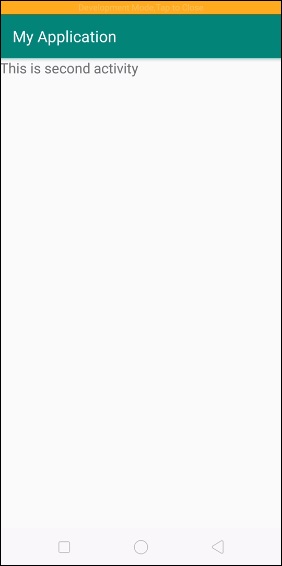
 Data Structure
Data Structure Networking
Networking RDBMS
RDBMS Operating System
Operating System Java
Java MS Excel
MS Excel iOS
iOS HTML
HTML CSS
CSS Android
Android Python
Python C Programming
C Programming C++
C++ C#
C# MongoDB
MongoDB MySQL
MySQL Javascript
Javascript PHP
PHP
- Selected Reading
- UPSC IAS Exams Notes
- Developer's Best Practices
- Questions and Answers
- Effective Resume Writing
- HR Interview Questions
- Computer Glossary
- Who is Who
What is an Intent in Android?
An intent is to perform an action on the screen. It is mostly used to start activity, send broadcast receiver,start services and send message between two activities. There are two intents available in android as Implicit Intents and Explicit Intents. Here is a sample example to start new activity with old activity.
Step 1 − Create a new project in Android Studio,go to File ⇒ New Project and fill all required details to create a new project.
Step 2 − Add the following code to res/layout/activity_main.xml. (First Activity layout)
<?xml version = "1.0" encoding = "utf-8"?> <android.support.constraint.ConstraintLayout xmlns:android = "http://schemas.android.com/apk/res/android" xmlns:tools = "http://schemas.android.com/tools" android:layout_width = "match_parent" android:layout_height = "match_parent"> <LinearLayout android:layout_width = "match_parent" android:layout_height = "match_parent" android:gravity = "center" android:orientation = "vertical"> <Button android:layout_width = "wrap_content" android:layout_height = "wrap_content" android:text = "Send to another activitys" android:id = "@+id/send"/> </LinearLayout> </android.support.constraint.ConstraintLayout>
Step 3 − Create a new layout in res/layout/ folder and add the following code to res/layout/activity_main.xml. (Second Activity layout )
<?xml version = "1.0" encoding = "utf-8"?> <android.support.constraint.ConstraintLayout xmlns:android = "http://schemas.android.com/apk/res/android" xmlns:app = "http://schemas.android.com/apk/res-auto" xmlns:tools = "http://schemas.android.com/tools" android:layout_width = "match_parent" android:layout_height = "match_parent" android:layout_centerInParent = "true" android:layout_centerHorizontal = "true" tools:context = ".SecondActivity"> <TextView android:id = "@+id/data" android:textSize = "20sp" android:layout_width = "wrap_content" android:layout_height = "wrap_content" /> </android.support.constraint.ConstraintLayout>
Step 4 − Add the following code to src/MainActivity.java (First activity)
import android.content.Intent;
import android.os.Bundle;
import android.support.v7.app.AppCompatActivity;
import android.view.View;
import android.widget.Button;
public class MainActivity extends AppCompatActivity {
@Override
protected void onCreate(Bundle savedInstanceState) {
super.onCreate(savedInstanceState);
setContentView(R.layout.activity_main);
Button send = findViewById(R.id.send);
send.setOnClickListener(new View.OnClickListener() {
@Override
public void onClick(View v) {
Intent send = new Intent(MainActivity.this, SecondActivity.class);
startActivity(send);
}
});
}
}
In the above activity we are starting new activity using startActivity(). To start activity, we need to create new intent and we have to pass current activity and new activity as shown below.
Intent send = new Intent(MainActivity.this, SecondActivity.class); startActivity(send);
Step 4 − Create a new activity and add the following code to src/SecondActivity.java (Second Activity)
package com.example.andy.myapplication;
import android.support.v7.app.AppCompatActivity;
import android.os.Bundle;
import android.widget.TextView;
public class SecondActivity extends AppCompatActivity {
@Override
protected void onCreate(Bundle savedInstanceState) {
super.onCreate(savedInstanceState);
setContentView(R.layout.activity_second);
TextView data=findViewById(R.id.data);
data.setText("This is second activity");
}
}
Step5 − Add the following code to AndroidManifest.xml.
<?xml version = "1.0" encoding = "utf-8"?> <manifest xmlns:android = "http://schemas.android.com/apk/res/android" package = "com.example.andy.myapplication"> <application android:allowBackup = "true" android:icon = "@mipmap/ic_launcher" android:label = "@string/app_name" android:roundIcon = "@mipmap/ic_launcher_round" android:supportsRtl = "true" android:theme = "@style/AppTheme"> <activity android:name = ".MainActivity"> <intent-filter> <action android:name = "android.intent.action.MAIN" /> <category android:name = "android.intent.category.LAUNCHER" /> </intent-filter> </activity> <activity android:name = ".SecondActivity"></activity> </application> </manifest>
In the above code, we have declare MainActivity and SecondActivity as shown below.
<activity android:name = ".SecondActivity"></activity> <activity android:name = ".MainActivity""></activity>
Let's try to run your application. I assume you have connected your actual Android Mobile device with your computer. To run the app from android studio, open one of your project's activity files and click Run ![]() icon from the toolbar. Select your mobile device as an option and then check your mobile device which will display your default screen.
icon from the toolbar. Select your mobile device as an option and then check your mobile device which will display your default screen.

Now click on Button to start new activity as shown below.

Click here to download the project code

